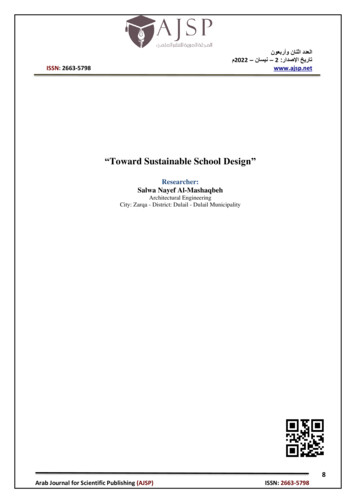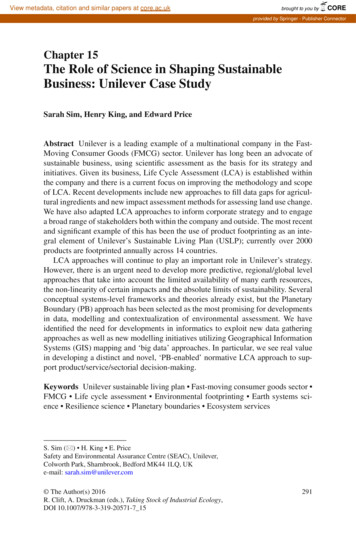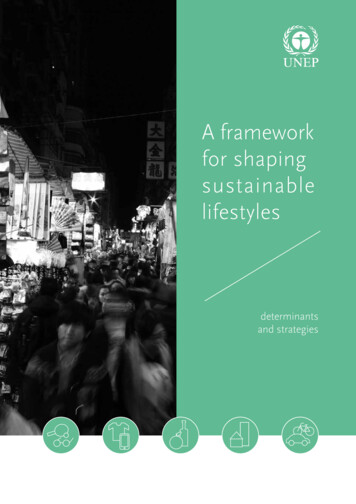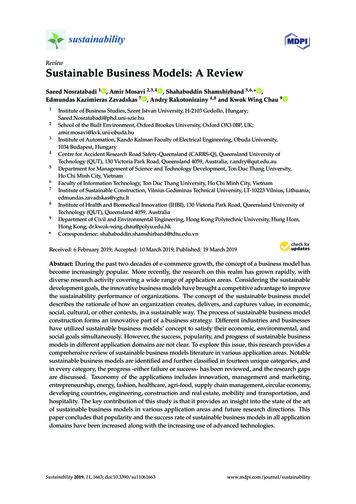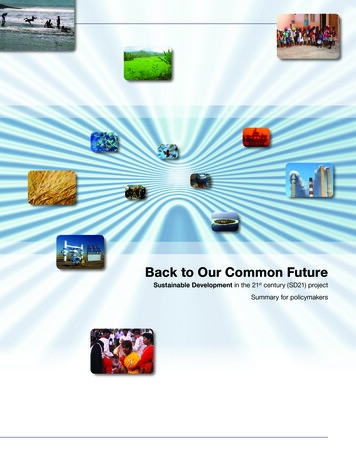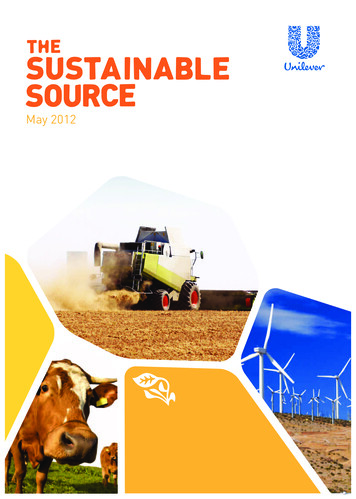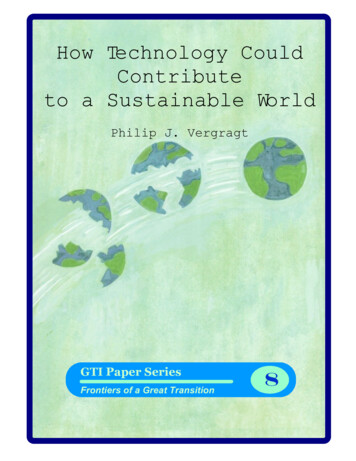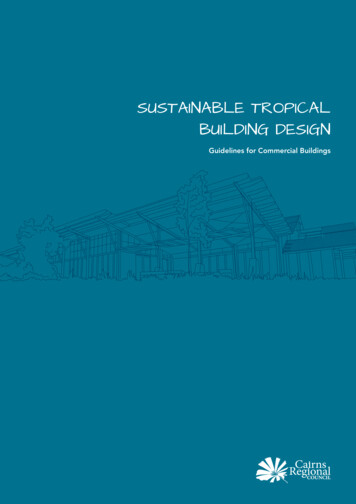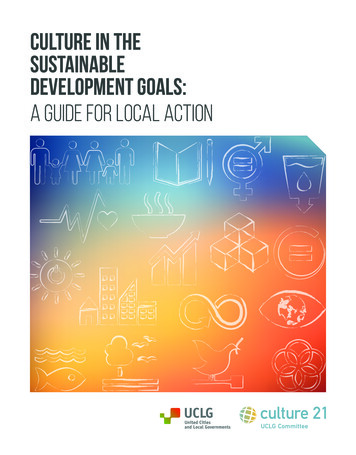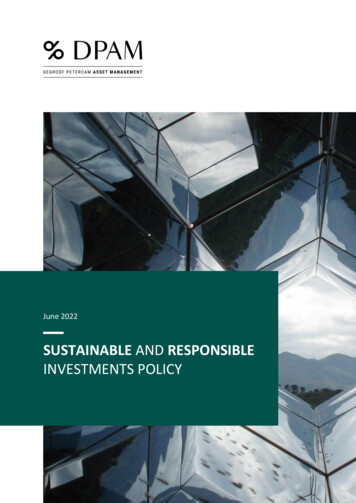
Transcription
June 2022SUSTAINABLE AND RESPONSIBLEINVESTMENTS POLICY
CONTENTSI.INTRODUCTION3II.4DPAM A RESPONSIBLE INVESTOR SINCE 20011.Scope of the policy62.Objectives of the policy63.Responsibilities6III.EXECUTIVE SUMMARYIV.DPAM IS A COMMITTED SUSTAINABLE ACTOR1.Strong conviction in sustainable and responsible investments710101.1Signatory of UN PRI since 2011101.2Signatory of the Net Zero Asset Management Initiative (NZAM)102.Membership to several international forums that advocate sustainable investments123.Supporter of ambitious and successful initiatives on engagement134.DPAM Stewardship - Active ownership144.1Shareholder responsibility – Proxy voting144.2Engagement144.2.1 Engaging as a bondholder155.Conflict of interest policy166.Policies and Governance167.V.6.1DPAM’s Board of Directors responsible for the ESG oversight166.2The four DPAM’s foundation/reference policies176.3Governance and steering bodies176.3.1 The Fixed Income Sustainability Advisory Board (FISAB)176.3.2 The Voting Advisory Board (VAB)176.3.3 The TCFD Steering Group186.3.4 The Responsible Investment Steering Group19People, resources and capabilities7.1The Responsible Investment Competence Center207.2Integration into research and portfolio management teams207.3External resources22DPAM IS A COMMITTED SUSTAINABLE INVESTOR1.2.20ESG: DPAM’s ance28ESG factors integration: integration principles302.1Risk return optimization302.2Time horizon302.3Materiality of ESG criteria312.4Sector specific ESG factors322.5Engaged Dialogue and promotion of Best Practices322.6Continuous improvement322.7Holistic and transversal approach331
3.4.ESG factors integration: integration by asset classes3.1Integration in listed equities353.2Integration in Corporate Bonds363.2.1 DPAM Green, Social & Sustainability (GSS) Corporate Bond Policy363.337383.4Integration in third-party funds423.5Integration in impact investing in private equity42Sustainability risks integration43434.1.2 ESG risks analysis444.244Sustainability risks integration through the value chain of investment process4.2.1 The in-depth fundamental research, articulated around the principal adverse impact indicators (PAI)454.3Statement on the priorities to integrate the Principal Adverse Impact indicators (PAI)484.4Sustainability risks and potential impact on financial performance of products49DPAM’S METHODOLOGY AND INVESTMENT PROCESS5.252The starting framework: PRI signatory and Net Zero commitment i.e. ESG integration,active ownership and GHG emissions commitment are a commodity for DPAM53DPAM is committed to reduce the negative impact of its investment decisions –promotion of E/S characteristic545.2.1 Defending fundamental rights and ensuring the minimum social and governance safeguards545.2.2 Pragmatism and dialogue in controversial activity screening –Do Not Significantly Harm Principle (DNSH principle)545.2.3 Rigor, in-depth analysis and dialogue in controversial behavior screening –Do Not Significantly Harm Principle (DNSH principle)555.3VI.Sustainability risks covered by the DPAM Risk Committee434.1.1 ESG profile assessment5.16.Integration in Sovereign Bonds3.3.1 DPAM Green, Social & Sustainability (GSS) Government Bond Policy4.15.34DPAM is committed to increase the positive impact of its investment decisions or recommendations –promotion of E/S objectives585.3.1 Promotion of E/S best practices to encourage best in class and best efforts585.3.2 Identification of sustainable instrument through a revenue-aligned approach605.3.3 Impact measurement and assessment – sustainability outcomes60DPAM is transparent on the aim of its investment funds and strategies – SFDR classification626.1Promoting environmental and social characteristics626.2Sustainable investment as a contribution to environmental and/or social objectives636.3In brief, how are Principal Adverse Impact indicators taken into account in the investment process?636.4In brief, how is the Do Not Significantly Harm (DNSH) principle guaranteed?64DPAM IS A COMMITTED SUSTAINABLE PARTNER REPORTING, DISCLOSURE AND TRANSPARENCY671.Transparency and confidence-building measures672.Committed to transparency – DPAM’s extra financial report673.Transparency of ESG methodologies684.Content and frequency of reporting695.Disclosure requirement69VII.LEXICON AND ABBREVIATIONS70VIII.SUMMARY OF RESPONSIBILITIES732
I.INTRODUCTIONThis document is the sustainable and responsible investment policy (hereinafter referred toas the “SRI Policy”) of Degroof Petercam Asset Management (hereinafter referred to as“DPAM”), a subsidiary of the Degroof Petercam group. It has been validated by theManagement Board in June 2022. It amends and restates the first version of the SRI Policywhich was released in March 2016.It is applied consistently to all investment funds which are managed by DPAM, bydesignation or delegation (to the extent agreed between DPAM and the delegatingmanagement company (the “DPAM Funds”) and to discretionary portfolio managementmandates DPAM manages on behalf of institutional asset owners/investors. It is also partof the considerations that DPAM takes into account when providing investment advisoryservices to its clients. It describes the adopted sustainable approaches (ESG integration,best-in-class, sustainability themes, norms-screening, etc.) DPAM can apply across all assetclasses. DPAM is convinced about sustainable and responsible investments and this is deeplyingrained in its corporate DNA since 20013
II. DPAM A RESPONSIBLE INVESTOR SINCE 2001Being a responsible investor goes beyond offering responsible products; it is a globalcommitment at company level translated into a coherent approach.Being a responsible investor first and foremost involves raising key questions about the consequences of DPAM’sinvestment activity in a global context, i.e., looking beyond pure financial profit and taking into account allstakeholders whilst considering the consequences of an investment. Raising questions, utilizing experts, sharinginformation and engaging with a positive yet critical mind-set imbeds DPAM professionals with a sense ofresponsibility and prompts them to act in full knowledge of the facts.As a shareholder representative and economic player, DPAM accepts its corporate responsibility. Understandingthe dynamic environment, we work in, embracing the complexity of this environment and its requirements withpragmatism and committing to implement and manage our assets according to these are key governanceprinciples for DPAM. Indeed, we understand and accept the dynamic and complex environment we have to dealwith: Scientific evidence cannot be ignored. Status quo is synonym for unwanted outcomes. The regulatory authorities should scrutinize investors and investees alike in a balanced fashion. Climate scenarios should guide and steer intensity of regulation and commitment of asset managers andinstitutional investors. Technological evolutions can only occur when they find proper funding.Integrating sustainability in investment processes is not straightforward. The objective is to have portfoliomanagers, analysts, and risk managers routinely apply the same processes across ESG factors as they assessopportunities & risks across business and financial parameters.To defend best practices in terms of corporate governance and ESG challenges, DPAM refers to various reputedsources such as: The International Corporate Governance Network (ICGN), The 10 Principles of the UN Global Compact, The OECD guidelines for multinational enterprises, The Sustainable Development Goals set up by the United Nations, The OECD Due Diligence Guidance for Responsible Business Conduct, The Principles of Responsible Finance, The recommendations of the Task Force Climate-related Financial Disclosure (TCFD), etc.DPAM is committed to sustainable investing and therefore adopts a view on corporate responsibility that isconsistent with the political agenda aligned with the Paris Agreement and with international standards andconventions.4
This policy is the 1st pillar of a set of sustainable and responsible investments related policies, namely: our Proxy Voting Policy (available here): the voting policy adopted by DPAM aims to defend the values andprinciples with regard to corporate governance that DPAM advocates and wishes to see applied by thecompanies in which DPAM invests, on behalf of DPAM Funds or clients in scope of this Proxy Voting Policy. Our Controversial Activities Policy (available here): whenever there is any doubt about a company’sinvolvement – be it already invested in portfolio’s or considered as a potential investment for portfolio’s –in the controversial activities, as listed in its policy, DPAM will have an engaged dialogue with the company’smanagement our Engagement Policy (available here): DPAM’s vision of being a responsible investor is articulated intothree pillars:1.raising key questions about the consequences of the company’s activities;2.being a shareholder who engages in a constructive dialogue with companies and ensuring the rights ofshareholders are fully exercised; and3.being committed to long-term objectives and sustainable financing.To implement its engagement policy, DPAM has set the dialogue with the different stakeholders at the heart ofthe process. The Policy describes the rationale for engaging with companies (and countries), expectations andthe different channels DPAM uses from formal dialogue through collaborative or individual engagements to moreinformal engaged dialogue during the numerous meetings with the management of companies organized by theresearch and investment teams.This Sustainable and Responsible Investments Policy describes and explains DPAM’s choices regardingsustainable and responsible investments. In its first part, it explains how DPAM is committed to SustainableInvestor through the important commitments and initiatives it has joined to contribute to sustainable financesworldwide next to other asset owners and managers. The second part describes how DPAM is a sustainable andresponsible investor by explaining the philosophy, approach and methodologies DPAM has adopted toimplement a pragmatic and ambitious approach to sustainable and responsible investments. Over the last 20years, DPAM has had the opportunity to proof the different methodologies such as norms screening, negativeand positive screening, engagement and impact. It explains what DPAM stands for when it refers to Active,Sustainable and Research. It describes DPAM’s philosophy and approaches compared to the various existingapproaches regarding sustainable and responsible investments that are enriching but at the same time possiblygenerate confusion and complexity. DPAM’s approach is threefold: ESG integration with or without promotingE&S characteristics and ESG impact by sustainable objectives. Because any investment has an impact, we shareour vision regarding impact intentionality and measurement. Finally, DPAM is committed to be a sustainablepartner, including our responsibility in terms of transparency and disclosure but as well in terms of sharingknowledge with stakeholders.5
1. SCOPE OF THE POLICYThe Policy is applied to all investment funds which are managed by DPAM, by designation or delegation (to theextent agreed between DPAM and the delegating management company) (the “DPAM Funds”) and todiscretionary portfolio management mandates DPAM manages on behalf of institutional asset owners/investors.It also makes part of the considerations that DPAM takes into account when providing investment advisoryservices to its clients. It describes the adopted sustainable approaches (ESG integration, best-in-class,sustainability themes, norms-screening, etc.) DPAM can apply in all asset classes. DPAM is convinced aboutsustainable and responsible investments and this is ingrained in its corporate DNA since 2001.2.OBJECTIVES OF THE POLICYThis sustainable and responsible investments policy aims at describing and explaining DPAM’s choices regardinginvestments with environmental and/or social characteristics and investments with sustainable objectives, inalignment with the Regulation (EU) 2019/2088 of the European Parliament and of the Council of 27 November2019 on sustainability‐related disclosures in the financial services sector (hereinafter called “SFDR regulation”).It lists the commitments of DPAM as a sustainable actor (§1) and explains what DPAM stands for when it refersto Active, Sustainable and Research as its strategic pillars.The description of DPAM’s philosophy and approach to sustainable and responsible investments include the wayDPAM identifies sustainability risks and ESG factors, which are integrated in its investment making decisionprocess (§2). Through the different choices, approaches and applied methodologies, DPAM’s aim is to optimizeits positive net impact on the society and to reduce as much as possible the negative impact of its investmentsby systematically integrating the question of the harmful impacts investments might have.Furthermore, DPAM aims at a high level of transparency regarding the different SRI approaches andmethodologies depending on the objectives of the funds and mandates, namely integrating ESG factors (a),promoting environment and social characteristics (b) and those with explicit environmental and/or socialobjectives (sustainable/impact objectives) (c). The approaches and implications are respectively explained (§3and §4). Finally, because any investment has an impact, we share our vision regarding impact intentionality andmeasurement (§5).3.RESPONSIBILITIESThe integration of Environmental, Social & Governance (ESG) factors is the shared responsibility of theinvestment professionals at DPAM i.e. portfolio managers, fundamental analysts and responsible investmentspecialists.Four governance bodies are involved in the SRI investment process: the Responsible Investment Steering Group(RISG), the Voting Advisory Board (VAB), the Fixed Income Sustainability Advisory Board (FISAB) and the TCFDSteering Group. The responsibilities are summarized in the table in Annex 1 to this Policy. These governancebodies report directly to the Management Board of DPAM, under the oversight of DPAM Board of Directors.6
III. EXECUTIVE SUMMARYDPAM is committed to sustainability and to be a responsible player since 2001, with athreefold engagement to sustainable investing: to uphold fundamental rights, to avoidcontroversial activities and finally, to be a responsible stakeholder by bringing sustainablesolutions to ESG challenges and by engaging with companies to foster best practices andevolutions.This document is the overarching policy, supported by a set of three policy documents (proxy voting,controversial activities, engagement) and applies to all investment funds, to discretionary portfolio mandatesand is part of the considerations taken into account by DPAM when providing investment advisory services.It describes DPAM’s choices, with which DPAM aims to optimize its positive net impact on the society and toreduce the negative impact of its investments on society as much as possible.Four governance bodies are involved in the process: the Responsible Investment Steering Group (RISG), theVoting Advisory Board (VAB), the Fixed Income Sustainability Advisory Board (FISAB) and the TCFD steeringgroup. The ESG strategy is supervised by DPAM’s Board of Directors.Challenges such as sound corporate governance, vision of environmental challenges and respectful social licenseto operate are an integral part of DPAM’s mission and value statement:“Our aim is to perform and to be best-in-class in our expertise and guardian of DPAM’s shared valuesand culture. We thrive on the conviction that actively managed, sustainable, research-based clientsolutions or portfolios offer the best opportunities for superior long-term investment results. This is thereason why Environmental, Social and Governance (ESG) considerations are integrated into our valueproposition, our fundamental research and our investment processes. As an active manager, wecombine financial objectives with our pioneering role as sustainable actor, both at the service of ourclients, our people and society.”As such, DPAM positions itself at three levels of commitment: as an actor (corporate commitment), as an investor(as part of investment processes and decisions) and as a partner (education, reporting, disclosure andtransparency).7
As a sustainable actor, DPAM is committed to major organizations which share the common aim of promotinglong-term sustainable investments. By adhering to UN six Principles for Responsible Investments (PRI) in 2011,DPAM commits to adopting and implementing these core guiding principles for sustainable finance. Bysupporting key initiatives, particularly the Net Zero Asset Management (NZAM) initiative but also Climate Action100 and the TCFD recommendations, DPAM shows its acknowledgment to the international policy agenda’s fora sustainable and inclusive growth. To fulfil its responsibility and fiduciary duty, DPAM has defined and set uprelevant policies and bodies governing its investments’ activities. It can also rely on the appropriate resources interms of research, be it internal with the full adherence of DPAM investment professionals or be it external withthe reliance on several reputed global sources of information and tools.As a sustainable investor, DPAM is convinced of the risk/return optimization of ESG factors integration. Theseare used to assess sustainability risks and opportunities of investment decisions.To offer solutions aligned with the 2030-2050 Program for a sustainable and inclusive growth and to put itsportfolio management expertise to serve the key ESG priorities, DPAM has identified and integrated theenvironmental, social and governance criteria according to the specificities of asset classes and economicactivities. Based on quantitative and qualitative research, the approach focuses on the most material ESG factorsi.e. those which could affect the core drivers and most important financial metrics of the company. These aretherefore defined for each particular industry and according to the time horizon of the investment decisions andcircumstances of the portfolio’s construction. Engaging in dialogue with the issuer, either through proxy votingor direct dialogue is at the heart of the process to fine tune fundamental research-driven investments decisionsand to spread best practices and innovative solutions for ESG challenges.This in-depth integration of ESG factors is closely interconnected with the identification of the sustainability risksi.e. environmental, social or governance event or condition that, if it occurs, could cause a negative materialimpact on the value of the investment. Through a rigorous disciplined screening of the controversial behaviourof the investee companies, DPAM aims at defending the fundamental rights as stipulated in the Global Standards,in particular the Global Compact principles and to reduce its negative impact by avoiding any activity or behaviourwhich could significantly harm a sustainable and inclusive growth as promoted by the EC 2030-2050 program.Finally, DPAM is transparent on the aim of its investment funds and strategies. Aligned with the so-called SFDRregulation, it makes a distinction between the portfolios promoting environmental and social characteristicsfrom those promoting environmental and social objectives. The search for a positive impact is at the heart of theportfolio construction when promoting environmental and social objectives. Firstly, through a strict screeningbased on controversial activities and behaviour and engaged dialogue, DPAM aims to reduce as much as possiblethe negative impact of any investment decision. Secondly, by establishing a straightforward link with the UNSustainable Development Goals, the investments aim at offering solutions to ESG challenges i.e. contributingpositively to one of the 17 goals.As a sustainable partner, DPAM is convinced that education and transparency are key pillars to accompany itsclients but also the society throughout the whole journey of sustainable investments.The four governing policies are therefore publicly disclosed namely the controversial activities policy, theengagement program, the voting policy and this SRI policy.All activities related to sustainable investments – voting, engagement, investments, impact, etc. – are reportedregularly and also publicly disclosed.The sustainable investments section on the DPAM website aims to bring together all relevant informationrelating thereto.8
DPAM IS A COMMITTEDSUSTAINABLE ACTOR9
IV. DPAM IS A COMMITTED SUSTAINABLE ACTOR1. STRONG CONVICTION IN SUSTAINABLE AND RESPONSIBLE INVESTMENTSGiven the global challenges of the last decades, DPAM is convinced that integrating challenges such as soundcorporate governance, vision of environmental challenges and respectful social license to operate is a driver oflong term sustainable performance.This is integrated in its mission and value statement:“Our aim is to perform and to be best-in-class in our expertise and guardian of DPAM’s shared valuesand culture. We thrive on the conviction that actively managed, sustainable, research-based clientsolutions or portfolios offer the best opportunities for superior long-term investment results. This is thereason why Environmental, Social and Governance (ESG) considerations are integrated into our valueproposition, our fundamental research and our investment processes. As an active manager, wecombine financial objectives with our pioneering role as sustainable actor, both at the service of ourclients, our people and society.”1.1 Signatory of UN PRI since 2011Already in September 2011, DPAM, i.e. Petercam Institutional Asset Management at that time, signed the UnitedNations Principles for Responsible Investment (“UN PRI”) to foster the integration of ESG factors into theinvestment decision‐making process as fully convinced of the added value of ESG integration and the importanceof sustainable finances. In 2016, following the merger between Degroof and Petercam, it reiterated itscommitment to the UN PRI. By adhering to these UN PRI, DPAM commits to adopting and implementing the sixUN PRI guiding principles. This publicly demonstrates its commitment to consistently integrate ESG factors as anactively sustainable asset management firm, and to contribute to the development of a long‐term investmentapproach with a sustainable focus.The top rating A DPAM has achieved for its assessment report over the last 4 years is the evidence that DPAMis committed to implement the 6 principles of the UN-backed PRI.1.2 Signatory of the Net Zero Asset Management Initiative (NZAM)As an active asset manager and a sustainable actor, investor and partner, DPAM decided in April 2022, aftercareful consideration, to join the Net-Zero Asset Managers (NZAM) Initiative. This requires asset managers tocommit to support investing aligned with net zero emissions by 2050 or sooner.10
“By integrating climate change risks and opportunities in its investments decision process, DPAM hascontinuously assessed the impact of climate change on its investments and considered the impact of itsinvestments on climate change. So-called climate-related transition risks are continuously increasing.Hence, assessing our investees’ readiness via Net Zero commitments has become key in the investmentcase. As an investor, it is now time to take the next, natural step and commit to NZAM”Peter De Coensel, CEO DPAMPrior to tackling this significant undertaking, DPAM has performed a thorough feasibility study to measure howit could maximise the degree of its commitment without compromising the core tenets of its strategies.Confident about the results of this study, DPAM decided to join the NZAM Initiative and align its methodologywith the approaches endorsed by the Network Partners 1. This includes more specifically the Science-BasedTargets Initiative for Financial Institutions, which provide companies with a clearly defined pathway for reducingtheir emissions2.To become part of the NZAM Initiative, DPAM commits to several key goals: Working in partnership with asset owner clients on ‘Net Zero by 2050’ decarbonisation goals Setting an interim target for the proportion of assets to be managed in line with the attainment of net zeroemissions Reviewing these interim targets at least every five years to eventually cover 100% of AuM To fulfil these commitments, DPAM will abide by the ten-point action plan33 of NZAM.As DPAM is a member of CDP (formerly the Carbon Disclosure Project), the latter will oversee DPAM’s targetvalidation process within one year after the firm’s commitment and will be done in close collaboration. DPAMwill disclose detailed information and scope within the 12 months of joining the initiative.Please refer to our TCFD Report disclosed for all details regarding our climate action positioning andmanagement.It is important to understand the commitment of DPAM regarding this initiative as it has binding implications forall assets DPAM is managing. Therefore, any investment decision a portfolio manager can take, will always beengrained in this framework of targeting net zero GHG emissions by 2050. To achieve this by 2050 or earlier,intermediary milestones have been defined and a methodology has been retained.First of all, DPAM has retained the methodology based on the Sciences Based Target (SBT) protocol, which is aforward-looking approach, receiving the adherence of all our investment professionals. Indeed the methodologyrelies on the SBT portfolio coverage and the temperature rating i.e. the investees set a science-based GHGreduction target or align their emissions with a 1.5 C scenario.1Network Partners of the NZAM initiative include AIGCC, CDP, Ceres, IIGCC, IGCC, PRCompanies taking action – Science Based Targets3 Source: Net Zero Asset Manager Initiative, 20202 Source:11
Secondly, the adopted approach distinguishes the carbon-intensive sectors (TCFD sectors/transition) and theother sectors. Our ambition is to reach 75% of portfolio constituents with a SBT or emissions aligned with a 1.5 Cscenario by 2030 for the carbon intensive sectors for the funds categorised as Article 8 or 9. The next target willbe a 100% portfolio coverage by 2040. For the other sectors, the target is set at a minimum of 50% of portfolioconstituents with a SBT or emissions aligned with a 1.5 C scenario by 2030 for the funds categorised as SFDRarticle 8 and 9 and a target of 100% portfolio coverage by 2040.To achieve these, the engagements will be key up to 2025 to achieve the target of 2030, through collaborativeinitiatives like CDP, SBT campaigns but also through individual engagements benefiting from all fundamentalapproaches of DPAM.2. MEMBERSHIP TO SEVERAL INTERNATIONAL FORUMS THAT ADVOCATESUSTAINABLE INVESTMENTSAny investment decision has an impact. In order to demonstrate its commitment towards long‐term sustainablefinancial management, DPAM is a signatory to various organizations. They are all organizations, which share itsaim to advocate responsible investments. Its membership of international collaborative initiatives ensures thatit gains continuous insight into the challenges and opportunities that responsible investment entails.Next to its commitment to the UN PRI, DPAM is an active member of national forums for responsible investments,namely France (FIR), Spain (Spainsif), Italy (Finanza Sostenibile), Netherlands (VBDO Vereniging van Beleggersvoor Duurzame Ontwikkeling) and German‐speaking countries (FN
The Responsible Investment Steering Group 19 7. People, resources and capabilities 20 7.1 The Responsible Investment Competence Center 20 7.2 Integration into research and portfolio management teams 20 7.3 External resources 22 V. DPAM IS A COMMITTED SUSTAINABLE INVESTOR 25 1. ESG: DPAMs definition 25 1.1 Environment 25 1.2 Social 27
